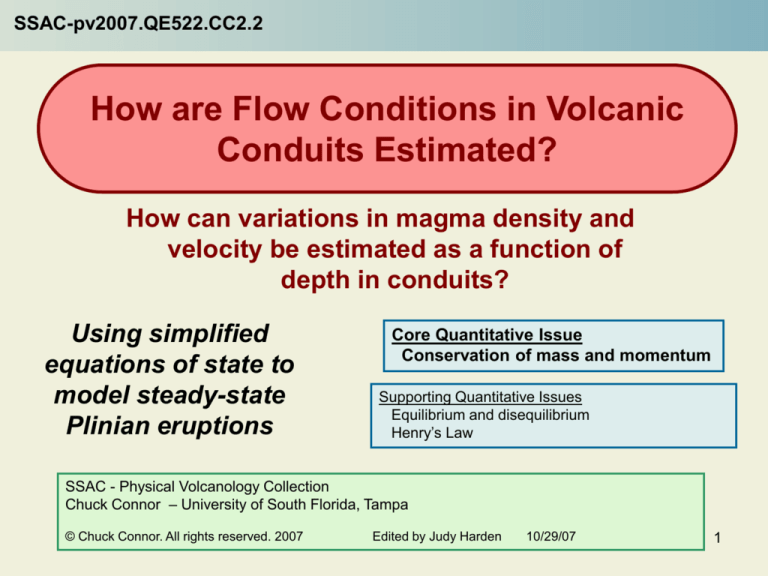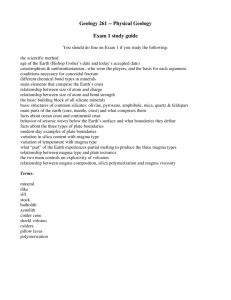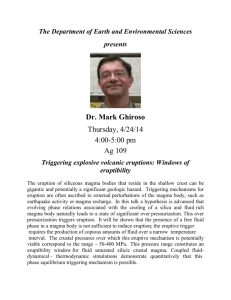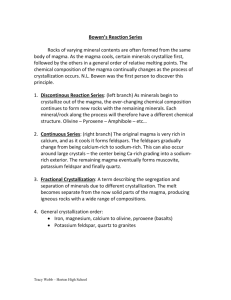
SSAC-pv2007.QE522.CC2.2
How are Flow Conditions in Volcanic
Conduits Estimated?
How can variations in magma density and
velocity be estimated as a function of
depth in conduits?
Using simplified
equations of state to
model steady-state
Plinian eruptions
Core Quantitative Issue
Conservation of mass and momentum
Supporting Quantitative Issues
Equilibrium and disequilibrium
Henry’s Law
SSAC - Physical Volcanology Collection
Chuck Connor – University of South Florida, Tampa
© Chuck Connor. All rights reserved. 2007
Edited by Judy Harden
10/29/07
1
Preview
This module presents a calculation of the ascent velocity of magma in
a volcanic conduit.
Slides 3-9 give some background on processes operating in volcano conduits during Plinian
eruptions.
Slide 10 states the problem. What is the ascent velocity of magma as a function of depth?
Slides 11-14 analyze the problem and prompt you to design a plan to solve it. The problem
breaks down into parts: estimating the solubility of volatiles in the magma, the magma
density, and the velocity.
Slide 15 illustrates a spreadsheet that calculates an answer.
Slide 16 discusses the point of the module and provides a broader volcanological context.
Slide 17 consists of some questions that constitute your homework assignment.
Slide 18 discusses the speed of sound in magma.
Slide 19 provides data needed to solve the end-of-module assignments.
2
Background
Steady-State Plinian Eruptions
Plinian eruptions are among the
most intense volcanic eruptions on
Earth, characterized by large mass
of erupted pyroclasts (e.g., greater
than 1010 kg) and high eruption
column heights (e.g., greater than
20 km).
These eruptions are often
characterized by apparently steady
– or nearly steady – eruption
conditions. It is as if a fire hose of
magma flows from the vent for a
period of time, driven by pressure
in the magmatic reservoir that only
diminishes after a significant
volume of magma has erupted.
A plinian eruption column at Lascar
volcano, Chile, in 1993.
3
Background
Steady-State Plinian Eruptions
The volcano conduit can be
represented by several flow regimes
and transitions during steady-state
Plinian eruptions. These include
deep magma ascent due to pressuredriven flow (e.g., Poiseuille flow),
bubble nucleation and bubbly flow,
perhaps accompanied by crystal
growth, fragmentation, and
dispersed flow. These flow regimes
and transitions are simplified models
of the actual processes but do
capture the major characteristics of
the volcano conduit during steadystate Plinian eruptions.
More about flow conditions at the vent
Diagram from H. Mader.
Excess pressure initiates flow.
4
Background
Henry’s Law
Henry’s Law describes the
relationship between mass
fraction of volatiles that may be
dissolved in a magma and
pressure:
ns sP b
where ns is the mass fraction of
volatiles in solution (dissolved in
the magma), P is the pressure, s
and b are constants that depend
on composition of the magma.
For rhyolite magmas, b = 0.5, s =
4.1 x 10-6 Pa-0.5; and for basalt
magmas, b = 0.7 and s = 6.8 x 1010
Pa-0.7.
Henry’s Law for
magmas: The higher
the pressure, the
more volatiles can be
dissolved in the
magma.
Please check your understanding of
Henry’s Law. What is the solubility
of water in a rhyolite magma at a
depth of 1 km, assuming hydrostatic
pressure, r magma = 2500 kg m-3?
Recall P = rgh. Your answer should
be approximately 0.02. How much
can dissolve in the same magma at
250 m depth?
5
Background
Henry’s Law
Henry’s law provides guidance
about the mass fraction of
volatiles dissolved in the melt
and the mass of volatiles
exsolved from the melt – that is,
the fraction found in bubbles.
Mass fraction remaining in melt
(estimated with Henry’s Law)
The mass fraction of exsolved
volatiles in the magma at a given
pressure is:
nex no sP
b
where no is the initial mass
fraction of volatiles dissolved in
the melt before any bubble
formation takes place.
Mass fraction exsolved (total
volatiles in the bubbles)
Initial volatile fraction = mass fraction
in melt + mass fraction in bubbles
6
Background
Henry’s Law is not enough.
Henry’s Law is a nice leading
order indicator of saturation, but
in reality there is more to bubble
growth: nucleation, diffusion,
and decompression.
Henry’s Law applies to
equilibrium conditions in a
homogeneous magma.
Ascending magmas, however,
have little respect for equilibrium
conditions. It takes time and
energy for bubbles to form – a
process called bubble
nucleation, and it takes time for
them to grow. Such factors are
not considered in Henry’s Law.
When opening a
bottle of beer the
pressure changes
instantly, changing
the saturation of
volatiles, which
come out of
solution. Long
after the pressure
changes, however,
bubbles continue
to nucleate and
rise through the
beer, a situation
not well-predicted
by Henry’s Law.
7
Background
What is homogeneous bubble
nucleation?
Bubbles form when the magma
becomes super-saturated in
volatiles. Henry’s law provides a
clue about these conditions, but
experiments indicate that, at
least in some conditions,
magmas become extremely
super-saturated before bubbles
actually nucleate and begin to
grow. In pure melts, supersaturation may be of order
DP=80 – 100 MPa before bubble
nucleation proceeds rapidly.
Bubbles nucleating in a
“homogeneous” melt, that is
free of crystals, xenoliths,
and related material – an
example of homogeneous
nucleation.
8
Background
What is heterogeneous bubble
nucleation?
In reality, super-saturation
pressures can be reached before
bubbles ever form. In such
magmas, bubble growth often
occurs when bubbles nucleate
on crystal surfaces. In pure
melts, super-saturation may be
of order DP= 5 to 30 MPa, less
than the overpressures seen in
homogenous nucleation
experiments.
A bubble residing at its nucleation site on a zircon crystal.
The mineral grain creates a site for nucleation of the
bubble. The field of view is about 500 mm. (Photo from
experiments conducted by Hurwitz, S., and O. Navon,
1994, Bubble nucleation in rhyolite melts: Experiments at
high pressure, temperature and water content, Earth and
Planetary Science Letters, 122: 267-280).
9
Problem
Given pressure conditions in a volcano conduit as a function of
depth, what is the ascent velocity of the magma?
Use Henry’s law and conservation
of mass to estimate ascent velocity.
It is necessary to make some
simplifying assumptions in order to
estimate flow in the conduit. We will
solve the problem in simplified form,
by assuming one dimensional
steady-state flow. We will assume
that the pressure conditions along
the conduit are known, and solve for
velocity from pressure, using
Henry’s Law. More general solutions
exist, to actually solve for the
pressure as well, but these require
more elaborate computer programs.
Excess pressure initiates flow.
Diagram from H. Mader.
10
Designing a Plan, Part 1
Given pressure conditions in a
volcano conduit as a function
of depth, what is the ascent
velocity of the magma?
You will need to:
• Calculate the solubility of
volatiles in magma as a function
of depth with Henry’s law.
• Calculate the density of the
ascending magma as a function
of depth.
•Calculate the average ascent
velocity as a function of depth in
the conduit, using conservation
of mass.
Give answer in meters per second.
Notes:
(1) Assume that Henry’s law applies
and ignore super-saturation for the
time being.
(2) Also, assume that no gas is lost
from the conduit – that is, all of the
exsolved gas is retained in
bubbles. Of course this is an
important assumption, as some
gas could be lost through the walls
of the conduit.
(3) As you develop a plan for solving
this problem, keep careful track of
the additional assumptions that
you are required to make in order
to solve the problem!
11
Designing a Plan, Part 2
Calculate the solubility of volatiles in magma with Henry’s law.
As a first step, estimate the solubility of water in the magma and the mass
fraction of water exsolved from the magma.
Henry’s law gives the solubility as a function of pressure, assuming that magma is in equilibrium (not
super-saturated). The mass fraction of exsolved volatiles can be calculated if the initial volatile content
in the magma is known.
ns 4.1106 P
no ns
nex
1 ns
where ns is the solubility of water in
rhyolite magma, P is the pressure in Pa,
nex is the mass fraction of volatiles
exsolved from the magma, and no is the
initial volatile content in the magma.
This representation of Henry’s Law is called an equation of
state. In the context of this problem, this means that the
equation describes the behavior of one variable (solubility of
water or mass fraction of exsolved volatiles) in terms of
another physical property of the system (pressure). This
particular equation of state is only valid for rhyolite magmas
and water. The coefficients of the equation change with
magma composition and volatile species. Of course, use of
this equation of state assumes that Henry’s Law is valid.
Many models used in the Earth Sciences depend on
equations of state and it is important to always consider their
validity when using a model to solve a specific problem.
12
Designing a Plan, Part 2
Calculate the density of the ascending magma.
The density of the magma (in this case, the mixture of melt and bubbles)
can be estimated with the ideal gas law.
The density of the mixture under specific pressure conditions,
and assuming that Henry’s Law applies, is given by:
nex RT 1 nex
r
P
1
where r is the bulk density of the magma-gas mixture, nex is
the mass fraction of exsolved volatiles in magma in
unsaturated conditions, R is the gas constant expressed in
terms of mass (462 J kg-1 K-1) for water vapor, T is
temperature (K), P is pressure (Pa) and is the density of
the melt in unsaturated conditions.
Check the units of this
equation. Note that the
gas constant for water
vapor is expressed in
terms of J kg-1 K-1. What
are the normal units of
the gas constant. What
assumption is made in
expressing units in J kg-1
K-1 about the volatiles in
the magma?
13
Designing a Plan, Part 2
Calculate the average ascent velocity in the conduit for a rhyolitic magma with
an initial volatile content of 0.05 at a temperature of 1100 K and a density of 2500
kg m-3. The mass eruption rate is 3x107 kg s-1 and the conduit radius is 30 m.
Use conservation of mass to estimate the flow velocity.
Once the density of the magma as a function of depth is estimated, it is possible to estimate the velocity
of the flow along the conduit, for a given mass flow. In this case, a 1D velocity is calculated. That is, the
velocity is assumed to not vary from the center to the edges of the conduit. The actual velocity will be
higher in the center of the conduit and lower at the edge of the conduit.
Q
u 2
r r
where u is the average velocity, Q is the mass flow, r is the
radius of the cylindrical conduit and r is the density of the
magma, which varies as a function of depth.
14
Carrying Out the Plan: Spreadsheet to Calculate Ascent Velocity
2
3
4
5
6
7
8
9
10
11
12
13
14
15
16
17
18
19
20
21
22
B
C
D
E
F
G
Calculate the change in magma velocity as a function of depth in a conduit.
Given (for Rhyolite Magmas)
Initial Volatile Content
0.05
Henry's Law (s)
0.0000041
Henry's Law (β )
0.5
Magma Temperature
1100
Melt Density
2500
Gas Constant
462
Mass Eruption Rate
3.00E+07
Conduit Radius
30
Calculate
Depth
(m)
-5000
-4950
-4898.338711
-4829.183572
-4739.463552
-4623.544634
Pressure
H
mass fraction
rhyolite
rhyolite
K
kg m-3
J kg-1 K-1
kg s -1
m
solubility
A cell containing a
number that is
given information
A cell containing a
formula
n ex
(Mpa)
mass fraction mass frac.
128
0.04638620 0.00378958
125.26088
0.04588720 0.00431060
122.44191
0.04536792 0.00485221
118.66978
0.04466362 0.00558586
113.76128
0.04373016 0.00655656
107.37234
0.04248446 0.00784900
1/rho
rho
u
-3
0.000414
0.000416
0.000418
0.000422
0.000427
0.000434
(kg m )
2418
2405
2391
2371
2344
2304
(m s -1)
4.3876894
4.4113976
4.4372229
4.4742376
4.5270791
4.6049915
At this point, be sure to
implement this
spreadsheet and check
that your formulas
duplicate the values
shown. You will need
this spreadsheet to
complete the end-ofmodule assignment.
15
What you have done
You have calculated ascent velocity of magma in a conduit.
A fundamental challenge in volcanology is to estimate the conditions of flow and transport of magma as it
moves from a deep magma reservoir to the surface. These flow conditions cannot be observed. Rather,
evidence of flow conditions is preserved from ancient eruptions, as seen in the geologic record, and flow
conditions can be inferred based on observations from historical eruptions.
In volcanology, we rely on mathematical solutions to provide additional insight into the nature of flow
processes. These mathematical representations of flow depend on a physical understanding of magma
systems. Here, you have used a great many simplifying assumptions to estimate flow and transport.
Useful papers that discuss magma ascent in detail:
Jaupart, C., 2000, Magma ascent at shallow levels, In: Sigurdsson et al., eds.,
Encyclopedia of Volcanoes, Academic Press, 237-245. (an accessible discussion).
Woods, A.W., 1995, The dynamics of explosive volcanic eruptions., Reviews in Geophysics
33: 495-530.
16
End-of-Module Assignments
1.
Make sure you turn in a spreadsheet showing the worked example.
2.
Conduit pressures as a function of depth are given for a rhyolite magma (see
slide 19). Using given information on slide 15, calculate the change in solubility,
density, and velocity as a function of depth. What is the approximate exit velocity
of the magma from the conduit?
3.
Plot a graph of the change in pressure as a function of depth in this conduit.
4.
Plot a graph of the change in magma density as a function of depth. What is the
approximate level of fragmentation in this conduit?
5.
Plot a graph of the change in velocity as a function of depth. On this graph,
indicate zones of bubbly flow and dispersed flow.
6.
What assumptions have you made in these calculations?
17
More About the Exit Velocity
Calculate the speed of sound in the magma-gas mixture.
The speed of sound in the eruption is
given by the following expression:
uc
RT
nex
P
nex (1 nex ) RT
where uc is the speed of sound in the
magma-gas mixture, R is the gas constant
expressed in terms of mass (462 J kg-1 K-1),
T is temperature (K), nex is the mass
fraction of exsolved volatiles, P is pressure
(Pa), and is the density of the magma in
unsaturated conditions.
Return to Slide 4
In “choked” flow
conditions, the velocity
of the magma at the
vent is approximately
equal to the speed of
sound in the magma at
the vent. It is possible
to calculate the sound
speed (also called the
critical velocity) from
the physical properties
of the magma and flow
conditions (specifically
pressure).
18
Excel Worksheet Containing Problem Data
This Excel worksheet contains the data you need to complete the EOM assignments –
double click on the worksheet and copy-paste into Excel. The data extends beyond
what is shown here; be sure to copy all 51 lines.
Depth
-5000
-4950
-4898.34
-4829.18
-4739.46
-4623.54
-4477.56
-4309.77
-4168.93
-4048.12
-3944.45
-3855.72
-3780.03
-3715.75
-3661.42
-3615.75
-3577.61
-3545.98
-3519.97
-3498.76
-3481.63
-3467.93
-3457.11
Pressure
128
125.2609
122.4419
118.6698
113.7613
107.3723
99.21395
89.61468
81.2946
73.88282
67.23418
61.24374
55.82444
50.90257
46.41558
42.31038
38.54197
35.07211
31.86832
28.90284
26.15166
23.59354
21.20865
Return to E-O-M Assignments
19








